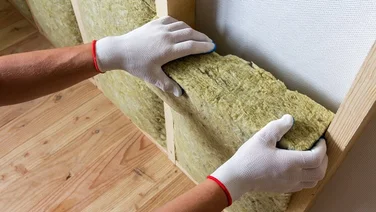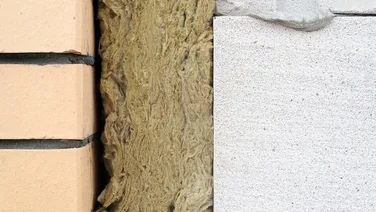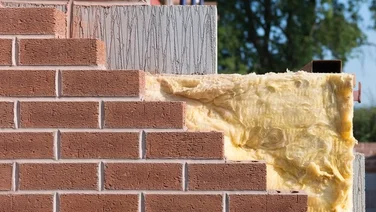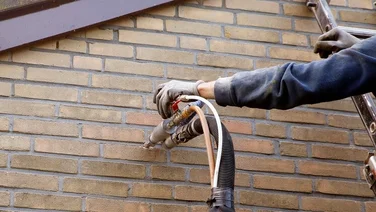- External wall insulation is a good option for homes with solid walls
- Insulation for walls can reduce your energy bills by up to £410
- External wall insulation costs around £11,000 on average
External wall insulation costs can be substantial compared to other types of insulation. However, it offers unique benefits, especially for properties with solid walls where internal solutions may not be suitable.
External wall insulation is a popular choice for many homeowners, but like all forms of insulation, it comes with advantages and disadvantages. We’ll go over what these are in this article, so you can make an informed decision.

What is external wall insulation?
External wall insulation is a type of solid wall insulation, where a layer of insulating material is added to the outside walls of a house.
The insulating material is then covered with render or cladding, and then a finish – these include smooth painted finishes, tiles, pebble-dashes, and brick slips.
External insulation is an alternative to internal insulation, where the insulating material is added to the inside walls – which slightly reduces the surface area inside the rooms.
What’s the best way to deal with condensation inside double glazing? Read our dedicated guide to find out.
The pros and cons of external wall insulation
- Does not reduce internal floor surface
- Improves home’s heat retention
- Reduces energy bills
- Installation doesn’t cause disruption
- Reduces risk of condensation on inner walls
- Expensive to install
- Changes the house’s external appearance
- Not suitable for listed buildings or those in conservation areas
- Can cause issues with damp
The advantages of external wall insulation
External wall insulation has many advantages, including improving your home’s heat retention and reducing your energy bills.
We’ll go over them in more detail in the following sections.
Internal floor surface isn’t reduced
One advantage of external wall insulation is that it doesn’t reduce the floor space inside your home.
External wall insulation is one of two insulation options for homes with solid walls. The other is internal wall insulation.
The issue with internal wall insulation is that it reduces the floor space in rooms by around 10 cm per wall. This isn’t the case with external wall insulation, since the insulating material is applied to the outside of the home.
Improved heat retention
External wall insulation, like all insulation, will improve heat retention in your home.
Around 25% to 45% of household heat is typically lost through poorly insulated walls.
Insulating measures such as external wall insulation will reduce heat loss, and make your home feel warmer.
Reduced energy bills
External wall insulation will improve heat retention in your home, which in turn reduces your energy bills.
This is because when less heat escapes from your home, your heating system doesn’t have to work as hard to get to the right temperature.
External wall insulation can save households up to £410 per year on energy bills, according to the Energy Saving Trust (EST).
Minimal disruption during installation
External wall insulation, unlike other forms of insulation such as spray foam insulation or floor insulation, causes minimal disruption when being installed.
Because external wall insulation is installed on the outside of a house, and not the inside, it doesn’t require you to remove all the furniture from any rooms, or have contractors take over a space in your house.
This means you can still use all the rooms in the house as normal during the installation process.
Less risk of condensation forming on internal walls
Condensation on internal walls is caused by the difference in temperature between the cold external air and the warmer internal air. This same principle applies to condensation on windows.
External wall insulation will act as an extra barrier between the inner wall and the external wall that’s exposed to cold air. This reduces the likelihood of condensation forming on the internal wall.

The disadvantages of external wall insulation
External wall insulation has some disadvantages, including cost – it’s expensive – and the fact that it changes the outside appearance of your home.
We’ll go over the disadvantages in detail in the following sections.
It’s expensive to install
The main drawback of external wall insulation is that it’s expensive.
External wall insulation typically costs £11,000 for the average home, according to the EST. This makes it one of the most expensive insulation options. By contrast, internal solid wall insulation costs £7,500, on average.
Outer appearance of the house is altered
Another disadvantage of external wall insulation is that it alters the outside appearance of your home.
It’s possible to choose finishes that mimic the original appearance of your home, such as painted plasterwork or cladding with brick slips. But these won’t necessarily form a perfect replica of the original external walls.
Not suitable for listed buildings or conservation areas
Because external wall insulation changes the outside appearance of your home, it’s not a viable option for most people who own listed buildings, or have homes in conservation areas.
Buildings that fall into either of these categories have regulations imposed on them that prevent owners from making changes to their external appearance.
If you live in one of these houses, you’ll have to apply for planning permission before making any changes to its appearance.
Since external wall insulation often leads to a quite drastic change in the appearance of a house, it’s unlikely you’ll be granted permission to install it.
Potential issues with damp
External wall insulation can usually help avoid condensation on a house’s internal walls. However, there are some cases where it can create a dampness problem.
One such case is when stone walls, which are relatively permeable – they allow air and moisture to pass through – are insulated with an impermeable material such as certain plastics.
Opting for natural materials such as wool and wood fibre, which are quite breathable, can reduce the likelihood of damp becoming a problem. These materials also tend to be cheaper than their synthetic counterparts, and are more eco-friendly.
Next steps
Properly insulating your home with measures such as external wall insulation will help you stay warm in the colder months, and can save you money on your energy bills.
Plus, since you’ll be using less energy on heating, your carbon footprint will also go down. In fact, insulation can save your household as much as 0.9 tonnes of carbon dioxide per year, according to the EST.
That’s a win for your wallet, and a win for the planet.
FAQs
Does external wall insulation keep heat out?
External wall insulation, like all types of insulation, can help keep the heat out in the warmer months.
Good insulation limits the transfer of air from the outside to the inside, and vice versa. This means it can also stop warm air from entering your house in summer, and keep cool air in.
Is it better to insulate walls internally or externally?
Whether it’s better to insulate walls internally or externally really is a matter of priorities.
Internal wall insulation will slightly reduce the surface area of your rooms, but it won’t change the external appearance of your home, making it a good option for listed buildings.
External wall insulation won’t affect the floor space inside your home, but it will change its outward appearance. This can be a positive side-effect if you want to change the look of your house, but if you’re very attached to your brick or stone front, it’s not a good choice.
What is the lifespan of external wall insulation?
External wall insulation usually lasts 25 years or more. In general, it’s designed to last as long as your house.
Over time, it’s normal for insulating material to experience some wear, so it’s a good idea to get any cracks repaired as soon as they appear.







